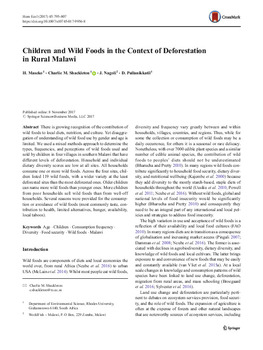Children and wild foods in the context of deforestation in rural Malawi
Abstract
There is growing recognition of the contribution of wild foods to local diets, nutrition, and culture. Yet disaggregation of understanding of wild food use by gender and age is limited. We used a mixed methods approach to determine the types, frequencies, and perceptions of wild foods used and sold by children in four villages in southern Malawi that have different levels of deforestation. Household and individual dietary diversity scores are low at all sites. All households consume one or more wild foods. Across the four sites, children listed 119 wild foods, with a wider variety at the least deforested sites than the most deforested ones. Older children can name more wild foods than younger ones. More children from poor households sell wild foods than from well-off households. Several reasons were provided for the consumption or avoidance of wild foods (most commonly taste, contribution to health, limited alternatives, hunger, availability, local taboos)

